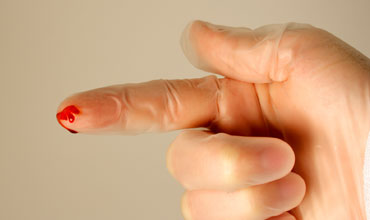Knowledge, attitude and practice towards needle stick injury among health care workers in a tertiary Sudanese hospital

Abstract:
Introduction:
Percutaneous
injuries, caused by needle sticks and other sharps, are a serious concern for all
health care workers (HCWs) and pose a significant risk of occupational transmission
of blood borne pathogen. Two million injuries are believed to
occur each year among HCWs. Methodology:
The study
group consisted of 249 HCWs of various categories of a tertiary care hospital in
Khartoum, Sudan. Data collection was carried out using a standardized questionnaire.
To measure knowledge, attitude and practices on needle stick injuries. Results:70%
of respondents were females and around 47% of participants were nurses Half of participants
attended a biosafety course, and around 90% of them followed what they was trained
on in all or most of times. Most of respondents graded their knowledge about as
good and the main source of knowledge was the university curriculum. In our study
46% had NSI with a mean of 6.1 injuries/year of 6.14 most of them were among nurses
40%. Almost thirty percent didn’t hear about the term post exposure prophylaxis
more than 90% knew that HIV, HBV, and HIV can be transmitted through NSI. More than
83% of respondents were worried about NSI. Regarding the most recent NSI, Most of
injuries occurred in the ward followed by emergency room, lab, and theatre. In half
of cases the culprit was the victim himself during usage of syringe. The most common
procedure associated with NSI was blood sampling. The frequent action was to wash
the injury site using antiseptic solution. Almost two thirds of respondents who
had NSI didn’t report it. Around 4.3% had NSI of HIV patient yet, the majority of
them did not receive any medication. Out the 7 participants who had a NSI from a
HBV positive patient, 5 were fully vaccinated all of which didn't check their vaccination
status. Moreover, none of the 5 participants received PEP. Conclusion and recommendation:
prevalence of NSI was relatively low but there were many deficient area such
as checking immune status of HBV, knowledge about importance and methods of PEP,
role of wearing gloves during handling needles, and procedure of reporting injuries.
HCW
=health care worker NSI = needle stick injuries PEP= post exposure prophylaxis
References:
[3.]
Desalegn,
Z., Gebreselassie S, and. Asemamaw Y, Epidemiology
of Needle Stick-Sharp Injuries (NSSIs) and Potential High Risk
Exposures among Health Professionals in Ethiopia: Neglected Public Health
Concern American Journal
of Health Research, 2015. 3(5): p.
298-304.
[9.]
Osman,
T., Epidemiology of sharp instruments
injuries at a dental school in Sudan. International Journal of Infection
Control, 2014. 10(4).
[13.]
Updated U.S.
Public Health Service Guidelines for the Management of Occupational Exposures
to HBV, HCV, and HIV and Recommendations for Postexposure Prophylaxis.
MMWR Recomm Rep, 2001. 50(Rr-11): p.
1-52.

